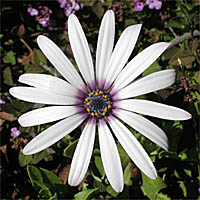


Difficulty Choosing Search Characteristics
The Sunflower family is one of the largest in the world, and indeed, it is the largest family of flowers in California. It also has a quite complex flower. This is hinted at in its other common name, the "Composite Family." It is one of only three groups that has its own diagram in the introduction of The Jepson Manual. This important family of flowers also presents us with some difficulty in our attempt to create a simple search tool for the average non-technical user. Specifically, it presents problems for three of the search categories: "Size", "Solitary/Clustered", and "Simple/Odd". Most people consider the "head" of the sunflower as if it were a single flower, and for that reason that is the way we have categorized it in the Flower Finder. However, the head of a sunflower is actually a very dense cluster of small, and sometimes oddly shaped flowers. So the technically correct choices in the Flower Finder for a typical garden daisy would actually be small, clustered, and odd!
In many cases where there might be confusion about how to make choices in the Flower Finder we have put the confusing flower into any category it might superficially appear to fit into. That is, no matter which choice is made, even if technically incorrect, the confusing flower appears in the search results. However, in the case of the sunflowers we felt the appearance of almost all of the sunflowers in the search results for "small" would itself be confusing to most people, especially since taken as a whole the head of a sunflower often qualifies as some of our largest flowers. The same would be true for the other two flower characteristics mentioned since the head of a sunflower often seems an almost perfect example of a solitary flower or a round (i.e., a simple) flower.
Sunflower Groups
Members of the complex sunflower family can also take on several different forms, generally determined by the existence or lack of a particular flower feature. Technical flower keys make use of this and divide the sunflower family into a dozen or more sub-families, tribes, or groups based on these features. These groups can greatly simplify the process of identification but the definitions of these groups can be rather technical and not always easy to discern at a glance in the field. In keeping with the philosophy of the original web site we have chosen to use only the simplest groups which are based on the presence/absence of the two different component flower types of the sunflower family, the "ray" flowers and the "disk" flowers. This results in just three simple groups:
Generally, the tiny disk flowers are tightly packed into a central "disk" surrounded by the usually larger and showier ray flowers (for example, each of the petals on a daisy is a single ray flower). In cases where it might be difficult to determine whether the ray flowers are present, we have usually categorized the flower based on the guideline that the ray flowers should be "obvious" in the field. This guideline has led us to place several members of the sunflower family that do possess diminutive ray flowers into the discoid group.
There is also the special case of the "Radiant" flower head, as shown in the last picture below. All the flowers of the Yellow Pincushion are technically disk flowers so we've placed in the discoid group. What is confusing is that the periphery is composed of greatly expanded disk flowers which can look at first glance like ray flowers. You can discern they are disk flowers when you notice that the outer flowers have the four or five lobes typical of a disk flower rather than the single large "strap" of a true ray flower. There are other oddballs that do not fit well into this simple scheme, like Acourtia microcephala with its two-lipped flowers, and Osmadenia tenella with its deeply lobed ray flowers.
So, the Sunflower family becomes one of those places of compromise. The Flower Finder attempts to take a very complex flower and reduce it to a few simple traits. The key concept here is to remember that things may not be what they seem at first glance. If the flower you are looking for does not seem to be appearing in the search results, then ease off on those characteristics you are not sure about. In the worst case you can always choose just the flower's color. That usually leaves you with only a few hundred or so pictures to look through :)
Many people would perceive several of these as large, simple, and/or solitary flowers.
Radiate (both ray and disk flowers)



